Service Function Chain in Small Satellite-Based Software De fined Satellite Networks
Taixin Li, Huachun Zhou,*, Hongbin Luo, Qi Xu, Si Hua, Bohao Feng
1 Beijing Jiaotong University, Beijing 100044, China
2 Beihang University, Beijing 100191, China
* The corresponding author, email: hchzhou@bjtu.edu.cn
I. INTRODUCTION
In recent years, due to the characteristics of global coverage, reliable transmission, and scalability, satellite networks have been widely used in communication, data transmission, navigation,remote sensing, and even Internet services.
However, traditional satellite networks have problems in structure design. In traditional satellite networks, a satellite is configured by the ground station only when it flies over the station. It will consume very long time to configure the whole network if the network has a large scale. This characteristic does not satisfy the need of managing satellites in real time,including collecting network status timely, and making management strategies dynamically.Traditional satellite networks employ scheduled link allocation, and static routing strategies,which make it dif ficult to support flexible traf fic scheduling, and changing needs of users.
There has been research about utilizing Software Defined Networks (SDN) [1] in multiple promising scenarios, for example,ubiquitous data center optical interconnection[2] and cloud radio access network [3]. To solve the structure design problem of satellite networks, some researchers have proposed to bring the technologies of SDN to satellite networks, forming SDSN. SDSN can support flexible and configurable satellite networks due to the characteristics of SDN, which decouples the control logic from the forwarding devices. SDN has been developed in terrestrial networks and achieved promising results.However, the research of SDSN has just begun [4] [5] [6]. There is just one article about implementing a SDSN prototype [7] based on OpenFlow [8] in the OpenStack environment to investigate SDSN.
In this paper, we have investigated a new method for flexible service delivery in the satellite networks, applying SFC in the small satellite-based SDSN.
Small satellites [9] are defined to be the arti ficial satellites with low weights and small size and are usually under 500Kg. Small satellites have several advantages, such as simple design, short development time, low cost,easy to launch, and strong survivability. These years, there is a rapid growth of the interest in using small satellites [10]. For example, One-Web plans a mega-constellation of at least 648 small satellites to provide low-delay and highspeed Internet service. A cluster of small satellites can fly in a formation. The satellites in a formation maintain relatively stable connections with each other. There has been research[11] about utilizing the on-board processing capability of satellites to process satellite traffic. Small satellites can carry network services that handle satellite data under control of the controller. The network services can be performance-enhancement-related, security-related, and data-processing-related. The small satellites are limited in computing capabilities and on-board resources due to their low cost.Therefore, small satellite cannot hold too much network services.
SFC [12] is proposed to provide flexible,reconfigurable, task-oriented and reusable network services. The network services can be chosen on demand and chained in a certain order. The traf fic is steered among the selected services and the network services can be shared among different traf fic. There have been a great increase of research about SFC these years [13-16]. However, we have not seen any research that applies SFC in satellite networks.
Traditional satellite service delivery method is based on the integrated network services provided by one big satellite [17][18]. However, utilizing distributed network services located on small satellites and chaining them as a SFC will achieve the following benefits against the traditional method. (1) Task-oriented. The network services can be chosen on demand. Diverse and customized satellite services can be provided. (2) Reconfigurable satellite services. Different set of network services are selected to form different satellite services. The traffic is steered among the selected network services under control of the controller. (3) Strong survivability. If one or some of the small satellites are broken, some services can still be provided using the remaining small satellites.
Motivated by this, in this paper, we propose to utilize SFC in the small satellite-based SDSN. In this way, we can steer the traffic among the network services on the small satellites flexibly and achieve processing of the satellite data before they arrive at the ground station. We provide two deployment patterns for SFC in SDSN, namely, Multi-Domain pattern and Satellite Formation pattern. Then, we propose two SFP algorithms for two patterns,SFP-MD and SFP-SF, respectively. In addition, we conduct experiments in our Open-Flow-based and OpenStack-based prototype.We aim to compare the performance of the patterns in terms of hops, delay, and packet loss rate and summarize the applicable conditions of the deployment patterns.
To sum up, our main technical contributions in this work are as follows.
· We propose two deployment patterns for SFC in SDSN, Multi-Domain pattern and Satellite Formation pattern. To the best of our knowledge, we are the first ones to apply SFC in the satellite networks.
· We propose two SFP algorithms for the patterns, SFP-MD and SFP-SF, and implement them in the OpenFlow-based and Open-Stack-based prototype.
· We conduct contrast experiments in our prototype and summarize the applicable conditions of the deployment patterns according to the experimental results. It will bene fit the further investigations of applying SFC in SDSN.
The rest of the paper is organized as follows. Section II reviews the related work. Section III gives a description of the deployment patterns for SFC in SDSN. Section IV presents the tests of the algorithms, SFP-MD and SFPSF, and the experimental results. Finally, Sec-tion V sums up the paper and provide a further discussion about the study.
II. RELATED WORK
In this paper, we focus on deploying SFC in the small satellite-based SDSN. In this section,we first review some recent related work on SDSN and small satellite. Then, we review the state of the art in SFC.
2.1 Software de fined satellite networks
Bao et al. [4] proposed OpenSAN, a software de fined network architecture. The authors aim to provide satellite network with high efficiency, fine-grained control, and flexibility by decoupling the data plane and control plane of each satellite. Jiang et al. [5] aimed to overcome the issues of node failures and dynamic topology changes of satellite networks. They propose a fast recovery routing algorithm for the SDN-based ORS satellite networking scheme. Yang et al. [6] proposed a seamless handover mechanism that is tailored to and takes advantage of SDSN. Then, the authors conduct physical layer simulation and the experimental results show that the SDSN-based handover protocol has advantage over the existing hard and hybrid handover schemes for satellite networks.
We focus on using the global control ability and flexible traf fic scheduling ability of SDSN rather than investigating the performance of SDSN in this paper.
2.2 Small satellite
Edmonson et al. [19] pointed out that a large number of heterogeneous small satellites can be deployed in space as a network using inter-satellite communications. Cello et al. [20]proposed ColdSel, an algorithm to mitigate possible congestion situations, to limit the nanosatellite (one kind of small satellite) buffer occupancy and to reduce the data delivery time in a Delay Tolerant Networking (DTN)based nanosatellite rural access network.There is also research about formation flight of the small satellites. Mazal et al. [21] presented a methodological study of cluster flight for disaggregated satellite systems. Furthermore,they presented a cooperative cluster establishment-keeping algorithm to enable the modules track a given orbit and keep a stable distance from each other.
In this paper, we use small satellites as the Low Earth Orbit (LEO) satellites that carry the network services. The reason is that small satellites have the advantages such as low cost,easy to launch, and strong survivability. We can deploy a large number of small satellites as a network to provide network services at a low cost. While the Medium Earth Orbit (MEO)satellites need a higher forwarding capability and the Geosynchronous Earth Orbit (GEO)satellites need a higher processing capability than the LEO satellites, therefore we prefer not to use small satellites as the MEO/ GEO satellites. In addition, we use the concept of satellite formation in one of the deployment patterns.
2.3 Service function chain
Wang et al. [13] investigated model and optimization of dynamic function composition problem. They developed a combinatorial optimization model and proposed a distributed algorithm using Markov approximation method. Taleb et al. [14] pointed out that the user generated content may cause severe congestion to mobile networks. The authors aim to address this challenge by exploiting SFC in data center that deployed in the Sgi-LAN.There is research about SFC in multi-domain scenario. Zhang et al. [15] presented a vertex-centric distributed orchestration framework for multi-domain networks and propose a distributed computing algorithm for mapping a service function chain request in multi-domain networks.
The research of SDSN and small satellites makes it possible to enable satellite networks provide flexible network services. We propose to apply SFC in satellite networks to provide flexible satellite network services. However,the research of SFC is all in terrestrial networks. In this paper, we aim to apply SFC in the satellite networks to provide flexible network services, where the networking mode is different from that in terrestrial networks.
III. DESCRIPTION OF THE DEPLOYMENT FOR SFC IN SDSN
In this section, we will introduce the structure of SDSN, and two deployment patterns designed for deploying SFC in SDSN to provide flexible network services. Then, we propose two SFP algorithms, which fit the characteristics of the MD pattern and the SF pattern.
3.1 Description of software de fined satellite networks
SDSN is typically based on the multi-layer satellite networks because there are some problems in the single-layer satellite networks, especially in single-layer LEO satellite network.Firstly, big blocking probability. The probability of link handover will increase with the increase of inter satellite links among single-layer satellites. The blocking probability will increase as a result. Secondly, weak survivability. Path diversity is weak in the single-layer satellite networks. It is difficult to find an alternative path that can satisfy the need of Quality of Service (QoS) after a link failure.

Fig. 1. Illustration of UDL, ISL, and IOL in the multi-layer constellation.
We first introduce three kinds of satellite links existing in SDSN, User Data Link, Inter Satellite Link, and Inter Orbit Link. Then, we introduce the structure of SDSN, the Control Plane and the Forwarding Plane.
1) User Data Link
User Data Link (UDL) is the satellite-ground link between the ground station and the satellites. A ground station can maintain multiple UDLs to different satellites in different layers. As is shown in Fig. 1, we set two kinds of UDLs, the UDLs between ground station and LEO satellites, and the UDLs between ground station and GEO satellites. The traf fic from the ground station needs to be sent to the access LEO satellite via UDL before it is forwarded in the satellite networks.
2) Inter Satellite Link
Inter Satellite Link (ISL) is the satellite link among the satellites in the same layer. There are two kinds of ISL, inter-plane ISL and intra-plane ISL.
A LEO satellite keeps three or four permanent ISLs. As is shown in Fig. 1, there are six planes of LEO satellites (marked as LEO1-* to LEO6-*). The satellites in LEO1-* and the satellites in LEO6-* fly in the opposite direction.We can say that there exists a reverse seam between LEO1-* and LEO6-*. The LEO satellites on both sides of the reverse seam keep three ISLs, two of which are intra-plane ISLs and connect the neighboring LEO satellites in the same plane. The other one is inter-plane ISL and connects the neighboring LEO satellite in the neighboring plane. The other satellites (in LEO-2* to LEO-5*) maintain four ISLs. Two of the ISLs are inter-plane ISLs and the other two are intra-plane ISLs.
A MEO satellite maintains two permanent intra-plane ISLs and several temporary inter-plane ISLs. As is shown in figure 1, there are two planes of MEO satellites (marked as MEO-1* and MEO-2*). The MEO satellites connect two neighboring MEO satellites in the same plane. MEO satellites create inter-plane ISLs to the MEO satellites in the other plane whenever possible.
A GEO satellite keeps two permanent intra-plane ISLs. As is shown in Fig. 1, we adopt one plane of GEO satellites, so there is no inter-plane ISL.
3) Inter Orbit Link
Inter Orbit Link (IOL) is the satellite link connecting the satellites in different layers.IOL is created temporarily when the lower layer satellites enter the coverage of the higher layer satellites. IOL is responsible for the communication between different layers.Therefore, IOL is unique and important in multi-layer satellite networks compared with the single-layer satellite networks. As is shown in Fig. 1, GEO satellites keep two kinds of IOLs, one kind is the IOLs to MEO satellites,and the other one is the IOLs to LEO satellites. MEO satellites keep IOLs to the LEO satellites that it covers.
4) Control Plane
Control Plane consists of GEO satellites.We deploy the controllers on GEO satellites for the reason that GEO satellites have a global view of the whole network. The controller on the GEO satellite collects the information of the satellite nodes and links via the IOLs and forwards this information to the ground station. The ground station sends instructions to GEO satellite via the UDL and GEO satellite distributes the instructions to the satellites it covers via the IOLs. The controller on the GEO satellite is very important because it is responsible for distributing instructions among the whole networks and preparing network information for strategies making.
5) Forwarding Plane
Forwarding Plane consists of MEO satellites and LEO satellites. SFC is achieved mainly based on this plane. The MEO satellites are responsible for forwarding the traf fic according to the instructions from the GEO satellites. The small satellite-based LEO satellites not only forward the traffic, but also carry the network services. The satellite traf fic is steered among the MEO satellites and the LEO satellites along the SFP.
3.2 Description of the deployment patterns
We de fine the link information that GEO satellite collects as the sets ISLLEO-LEO, ISLMEO-MEO,and IOLLEO-MEO. Here, ISLLEO-LEOmeans the ISLs among LEO satellites, ISLMEO-MEOmeans the ISLs among MEO satellites, and IOLLEO-MEOmeans the IOLs between the MEO layer and the LEO layer. The sets contain the connection information and distance information. We also de fine the coverage relationship as COV(x), which means the MEO satellites that cover the LEO x.
A list of requested network services will be generated before the transmission starts.We define the requested network services as the set REQSERVICES={S1,S2,…,Sn+2}.Then, we add up the access LEO satellite of the source ground station, the LEO satellite nodes that carry these network services, and the access LEO satellite of the destination ground station successively to generate the set REQNODES={N1,N2,…,Nn+2}. The path that chaining the requested network services is called SFP, and we de fine the SFP as the set of links PATH.
1) Multi-Domain Pattern
As is introduced in Section III A, the small satellite-based LEO satellites are covered by the MEO satellites. A MEO satellite can cover several LEO satellites and a LEO satellite can also be covered by more than one MEO satellite. We consider the MEO satellite and the LEO satellites that it covers as a satellite domain. All the satellites form a multi-domain scenario. We call the deployment pattern in this scenario as the Multi-Domain (MD for short in this paper) pattern. We call the MEO satellite in a domain as the Domain Head(DH), and DH(x) as the DH of the LEO x.
As is shown in Algorithm 1, we propose a heuristic algorithm, SFP-MD to calculate the SFPs in MD pattern. After generating the REQNODES, we need to work out the DHs for the nodes in REQNODES. If more than one MEO satellites cover the node k, we should select the MEO satellite which is closest to the node k as the DH according to the link information set IOLLEO-MEO. If there is only one MEO satellite that covers the node k, this MEO satellite is considered as the DH.
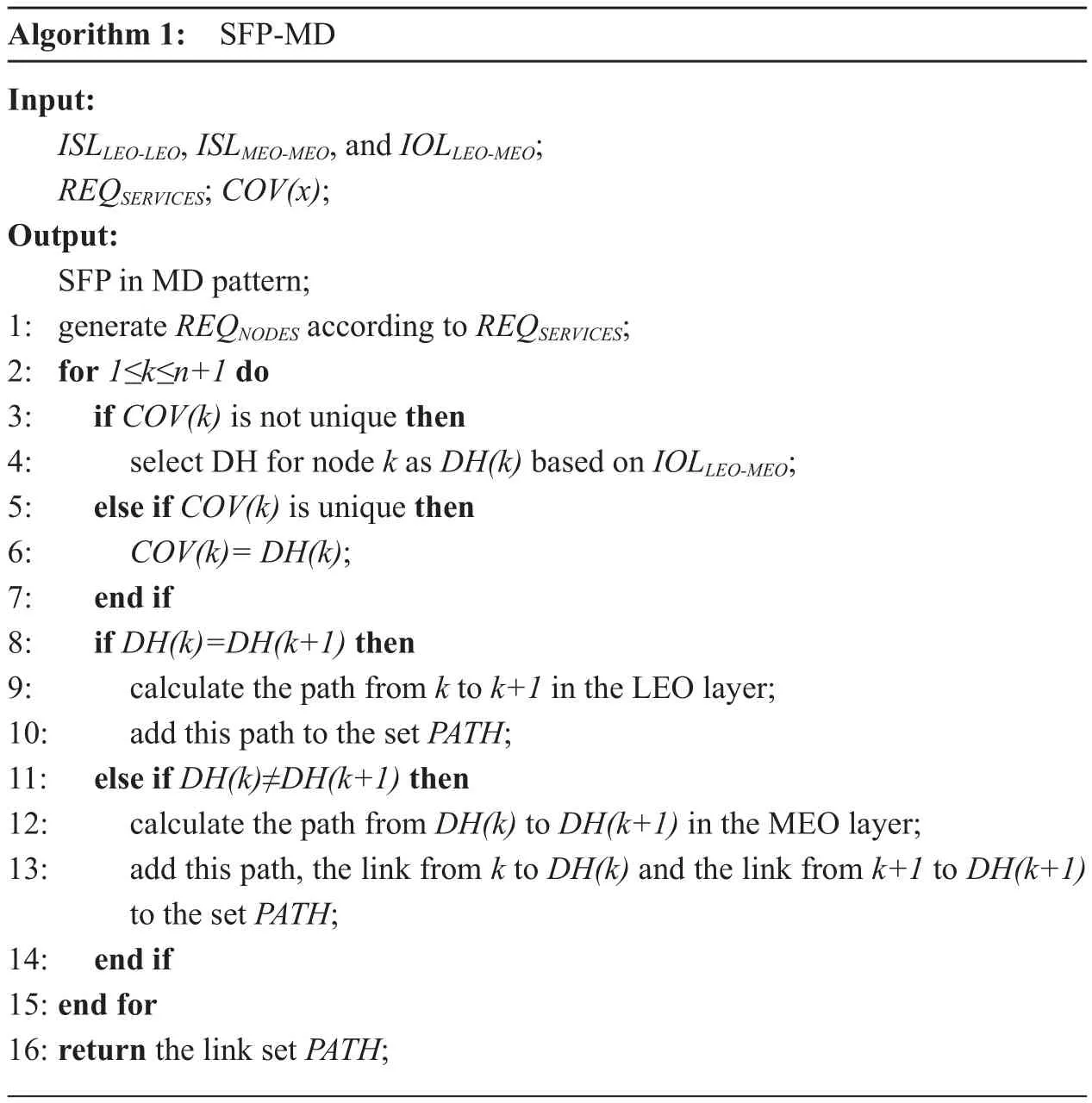
Algorithm 1: SFP-MD Input:ISLLEO-LEO, ISLMEO-MEO, and IOLLEO-MEO;REQSERVICES; COV(x);Output:SFP in MD pattern;1: generate REQNODES according to REQSERVICES;2: for 1≤k≤n+1 do 3: if COV(k) is not unique then 4: select DH for node k as DH(k) based on IOLLEO-MEO;5: else if COV(k) is unique then 6: COV(k)= DH(k);7: end if 8: if DH(k)=DH(k+1) then 9: calculate the path from k to k+1 in the LEO layer;10: add this path to the set PATH;11: else if DH(k)≠DH(k+1) then 12: calculate the path from DH(k) to DH(k+1) in the MEO layer;13: add this path, the link from k to DH(k) and the link from k+1 to DH(k+1)to the set PATH;14: end if 15: end for 16: return the link set PATH;
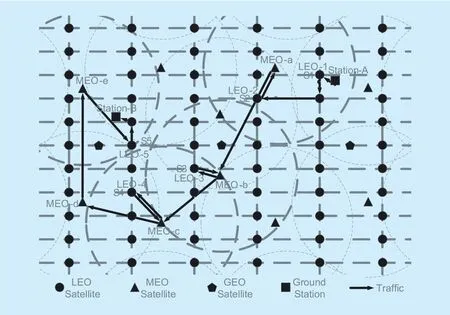
Fig. 2. Example of the routing algorithm for the MD pattern.
If node k and the next node in REQNODES,namely node k+1, are in the same domain, the traf fic should be forwarded in the LEO layer.We calculate the path from node k to node k+1 based on Shortest Path algorithm according to ISLLEO-LEOand add this path to the set PATH.If node k and node k+1 are in the different domain, the traf fic should be forwarded in the MEO layer. We calculate the path from node k to node k+1 based on Shortest Path algorithm according to ISLMEO-MEOand add this path to PATH. Then, we will get the whole SFP from the source ground station to the destination ground station in the MD pattern.
Figure 2 illustrates an example of the routing in the MD pattern. Tenants want to send data from the Station-A to the Station-B. In addition, they request for five services (S1 to S5) to process the data they send. S1 to S5 are deployed on LEO-1 to LEO-5, respectively.The access satellite of Station-A (LEO-1), and LEO-2 are in the same domain and the DH is MEO-a. Therefore, the traf fic is steered in the LEO layer. LEO-2 and LEO-3 are not in the same domain. The traf fic is sent to MEO-a and forwarded to MEO-b, which is the DH of LEO-3. LEO-3 and LEO-4 are in the different domain. The traffic is sent to MEO-b after processed by S3 on LEO-3 and forwarded to MEO-c, which is the DH of LEO-4. The DH of LEO-5 is MEO-e. Therefore, the traffic is forwarded to LEO-5 via MEO-d and MEO-e.Because LEO-5 and the access LEO satellite of the destination ground station are in the same domain, the traf fic is steered in the LEO layer to the destination, Station-B.
2) Satellite Formation Pattern
There are different types of Satellite Formations. The three most common types are trailing or leader-follower, cluster, and constellation [9]. Here, we adopt the trailing formation flying pattern to deploy SFC. We consider the LEO satellites in the same plane (LEO-1* to LEO-6* in figure 1) as a formation. We call the deployment pattern in this scenario as the Satellite Formation (SF for short in this paper)Pattern. We define the formation relationship of LEO satellites as FOR(x), which means the formation that LEO x in.
As is shown in Algorithm 2, we propose a heuristic algorithm, SFP-SF to calculate the SFPs in SF pattern. First, we should generate REQNODESaccording to REQSERVICES. If node k and the next node in REQNODES, node k+1, are in the same formation, the traffic should be forwarded in this LEO plane. We add the path from node k to node k+1 to the set PATH. If node k and node k+1 are in the different formation, the traffic should be forwarded in the MEO layer. The traffic should be sent from LEO satellite k to the nearest MEO satellite, and forwarded to the MEO satellite that is closest to LEO satellite k+1 in the MEO layer according to ISLMEO-MEO. We add this path to PATH. Then,we will get the SFP from the source station to the destination station in the SF pattern.
Figure 3 illustrates an example of the routing in the SF pattern. Tenants want to send data from the Station-A to the Station-B. They request for five services as the scenario in Fig.2. The Station-A first sends the traffic to the access LEO satellite, LEO-1, and this satellite happens to carry S1. LEO-1 and LEO-2 are in the different plane, therefore, the traf fic has to be forwarded in MEO layer. Because the nearest MEO satellite of LEO-1 and LEO-2 is the same one, MEO-a, the traf fic is forwarded via MEO-a. Similarly, LEO-2, LEO-3, and LEO-4 are in different formation, therefore, the traf fic is processed by S2, S3, and S4 on LEO-2, LEO-3, and LEO-4, respectively, and then forwarded by MEO-b, MEO-c, and MEO-d.LEO-4, LEO-5, and the access LEO satellite of Station-B are in the same formation, and the traffic is steered in the LEO satellites in the same plane. As last, the traf fic is forwarded to the destination, Station-B.
The satellite traf fic is forwarded in different way in the MD pattern and SF pattern. Therefore, the network services that located along the forwarding path are chained together in different way in the patterns.
IV. EXPERIMENTAL EVALUATION
In this section, we will introduce the design and the results of the experiments.
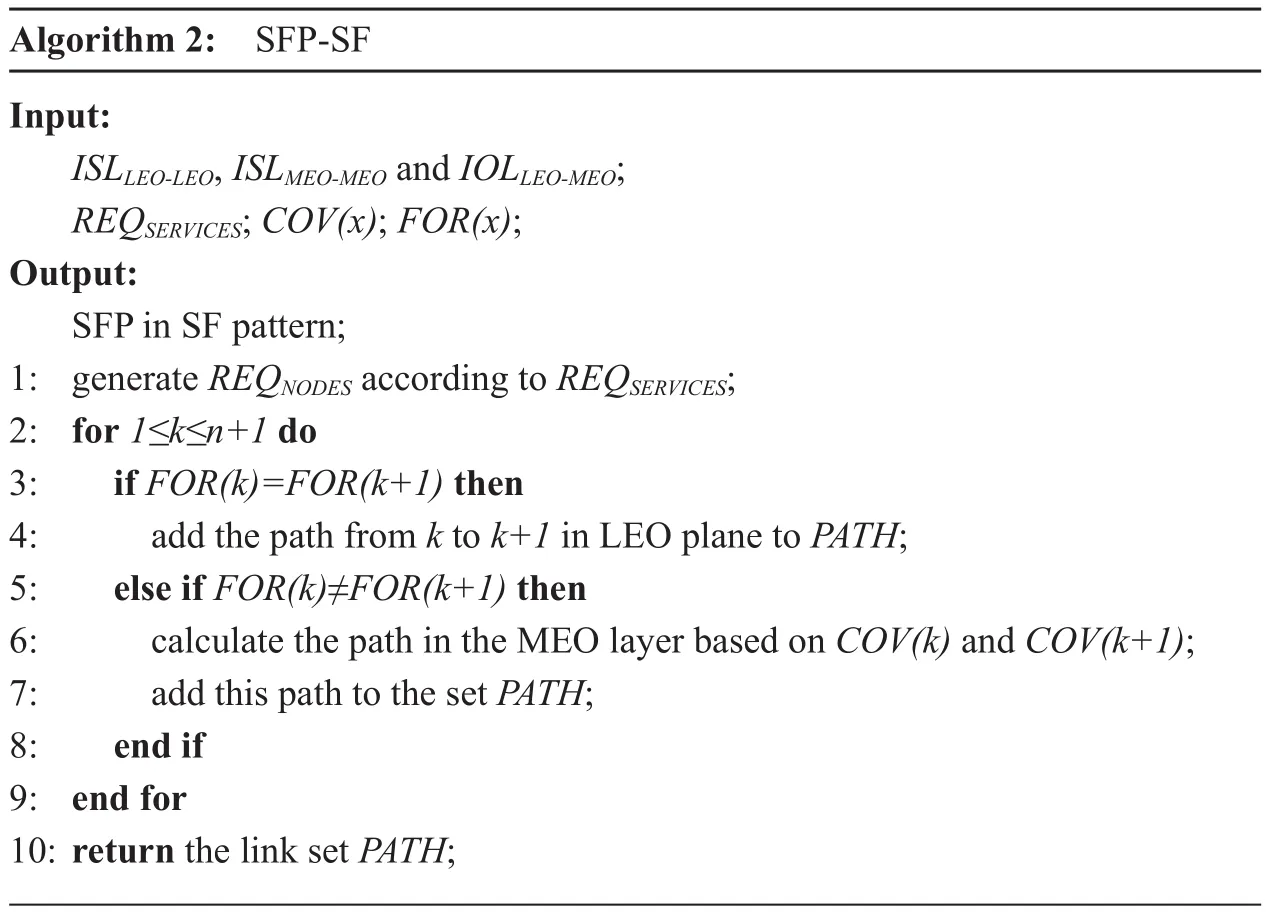
Algorithm 2: SFP-SF Input:ISLLEO-LEO, ISLMEO-MEO and IOLLEO-MEO;REQSERVICES; COV(x); FOR(x);Output:SFP in SF pattern;1: generate REQNODES according to REQSERVICES;2: for 1≤k≤n+1 do 3: if FOR(k)=FOR(k+1) then 4: add the path from k to k+1 in LEO plane to PATH;5: else if FOR(k)≠FOR(k+1) then 6: calculate the path in the MEO layer based on COV(k) and COV(k+1);7: add this path to the set PATH;8: end if 9: end for 10: return the link set PATH;

Fig. 3. Example of routing algorithm for the SF pattern.
4.1 Experimental design
We conduct experiments to compare the deployment patterns. As introduced in Section I, multi-layer satellite networks have advantages over the single-layer ones. We adopt the three-layer constellation named Tr [22]. We deploy Tr in Satellite Tool Kit (STK) and the parameters listed in Table I are based on Tr. We set two ground stations, Beijing station (116°E,40°N), and Washington station (77°W, 39°N).
The experiments are conducted in our SDSN prototype, which is based on OpenFlow and OpenStack. It is deployed on five high-performance servers and can hold several hundreds of nodes. We can create or delete nodes, and set link parameters free in the prototype. The link parameters, such as bandwidth, packet loss rate,and delay are set with the help of Linux Traf fic Control tool. The connections of UDLs, ISLs,and IOLs are created according to the introductions in Section III A.
The experimental parameters are listed in Table II. The total bandwidth of the UDLs and the ISLs in LEO layer is set 150Mbps. The total bandwidth of the ISLs in MEO layer and the IOLs between LEO layer and MEO layer isset 200Mbps. The source ground station sends data at rates between 1.4Mbps and 2.3Mbps,because the minimum of multi-media service is 1.4Mbps to meet the video demand for smoothly playing and the speed of 3G communication is approximately at 2.3Mbps [23].The source sends data at the speed of a random value between 1.4 and 2.3 in each experiment.The normal Bit Error Rate (BER) of satellite link is 10-6while 10-5means a relatively poor condition. Packet Loss Rate (PLR) can be calculate as PLR=1-(1-BER)packetlength, and the packet length is 1500 bytes. Therefore, the packet loss rate is set 0.15%-1.5%. We collect the distances of the links in STK at 8:00:00 and convert them to delay (divided by light speed). Then we set the delay in the prototype.

Table I. Parameters of the Three-Layer Constellateion
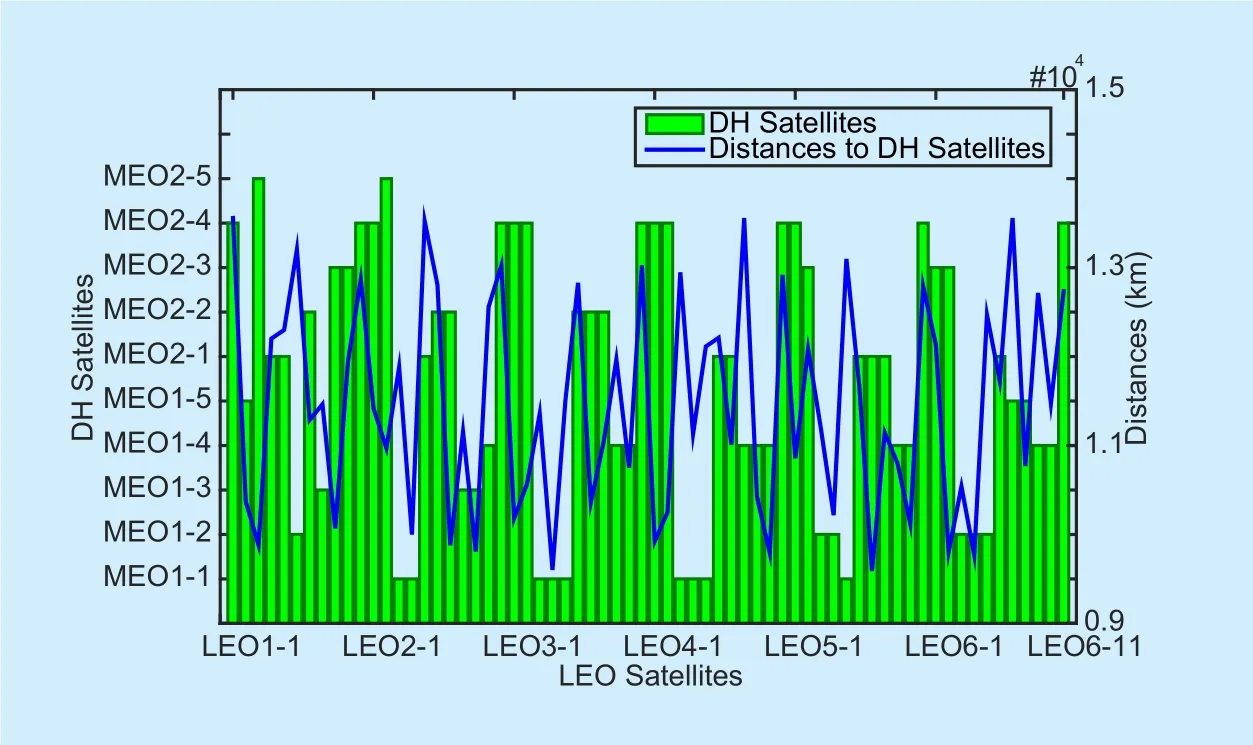
Fig. 4. DH satellites and the distances to DH satellites of the LEO satellites.
We embed POX controller on the GEO satellite node. We add a python-based module to achieve the calculation process of the SFPMD algorithm and the SFP-SF algorithm.Then, the flow rules are created according to the computing results of the algorithms. Open vSwicth (v2.5.0) is embedded on the MEO/LEO satellite nodes to forward the traf fic under the instructions from GEO satellite.
We design two sets of contrast experiments to test SFP-MD and SFP-SF. In each set of experiment, we design 12 scenes and the scenes are distinguished by the number of network services that the tenants request for. We assume that the tenants request for 1 to 12 network services. These services are distributed on the LEO satellite nodes in a random way and chained to a SFP in a flexible way. In each scene, we count the total hops, the number of used MEO satellite nodes and used LEO satellite nodes of the SFP. In addition, we collect the delay and the packet loss rate of the SFP.
4.2 Experimental results
As stated in Algorithm 1, we first need to work out the DHs for the needed LEO satellites. The DH satellites and the distances to DH satellites of the LEO satellites are illustrated in figure 4. We find out the DH satellites for the LEO satellites according to the distances from LEO satellites to the MEO satellites that cover them.
The number of total hops, used MEO satellites, and used LEO satellites on the SFP is shown in Fig. 5. We can see that in most scenes, the number of total hops of SFP-SF is no more than that of SFP-MD (except for the scene where 9 services are requested). In addition, when the number of services is not big(less than 7), the MEO satellites on the SFP calculated by SFP-MD is no more than those by SFP-SF. While the situation is contrary when the number of services is big (no less than 7). We can also see that the LEO satellites on the SFP calculated by SFP-SF is no more than those by SFP-MD when the number of services is not big (less than 8). The calculation result of SFP-MD uses more LEO satellites than that of SFP-SF when the number of services is big (no less than 8).
The delay of the SFPs calculated by SFPMD and SFP-SF in MD pattern and SF pattern is shown in Fig. 6. We can see that the delay of SFP-MD is no more than that of SFP-SF when the number of services is small (less than 7).However, when the number of services is no less than seven, the delay of SFP-SF is no more than that of SFP-MD.
The packet loss rate of the SFPs calculated by SFP-MD and SFP-SF in MD pattern and SF pattern is shown in Fig. 7. We can see that the packet loss rate of SFP-SF is less than that of SFP-MD in most scenes.
We can conclude from Fig. 5, Fig. 6, and Fig. 7 that the performance of SFP-SF is better than that of SFP-MD in terms of hops and packet loss rate. In other words, we can say that the SF pattern is better than the MD pattern. However, the conclusion would change if other requirements are considered. SFP-MD uses more LEO satellites than SFP-SF when the number of network services that tenants request for is small and the situation is contrary when the number of services is big. The delay of SFP-SF is bigger than that of SFP-MD when the number of services is small because SFP-SF uses more MEO satellites and the delay of links which contain MEO satellites is bigger than LEO satellites.
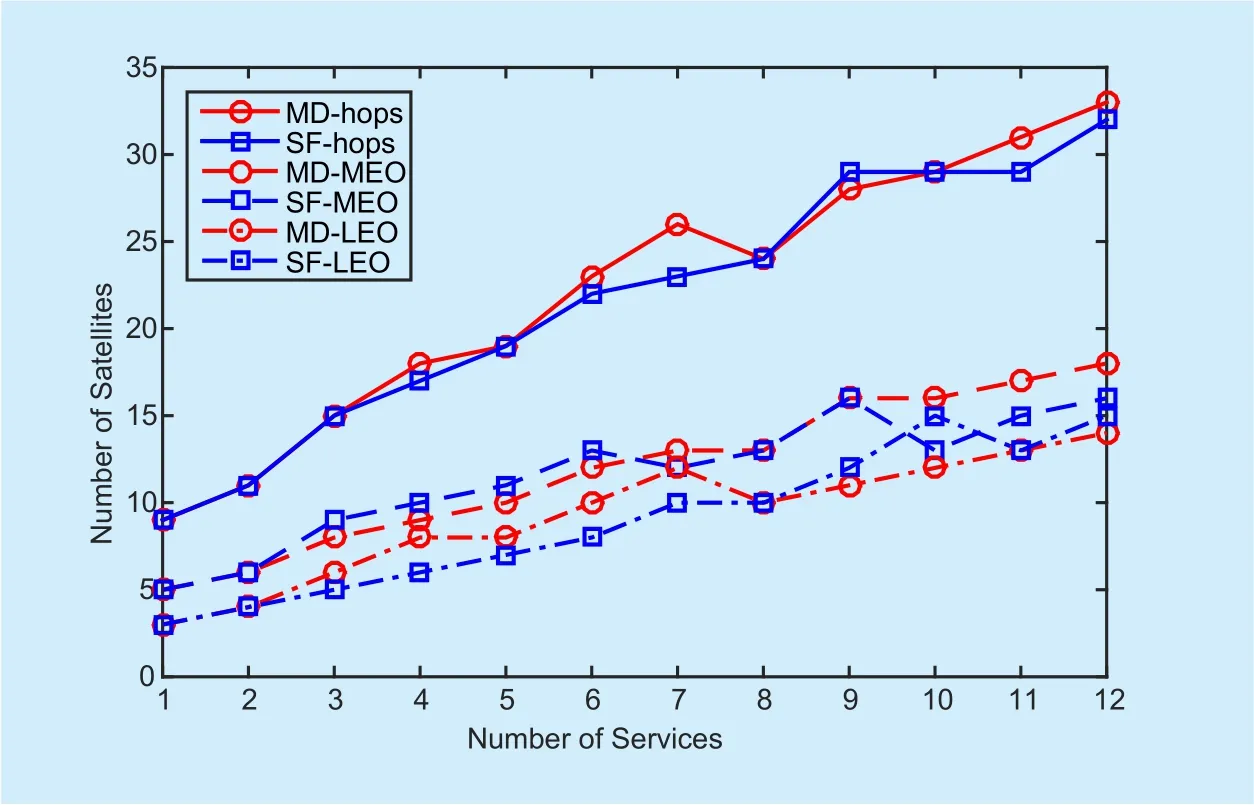
Fig. 5. Number of total hops, MEO satellites, and LEO satellites on the SFP.
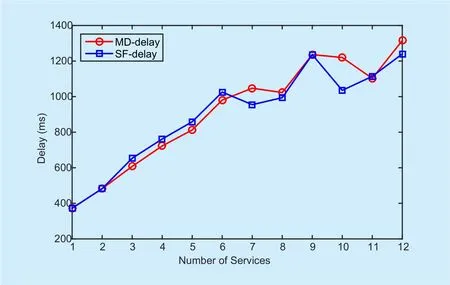
Fig. 6. Delay of the MD pattern and the SF pattern.

Fig. 7. Packet loss rate of the MD pattern and the SF pattern.
Therefore, if the tenants care more about the packet loss rate, the SF pattern is a better choice. If the number of deployed network services is small and the load on ISLs among LEO satellites is heavy, we should choose the SF pattern to reduce the network burden. If the number of services is small and the load on ISLs among MEO satellites is heavy, we should choose the MD pattern. While, when the number of network services is big, if the load on LEO satellites is heavy, we should use the MD pattern, and if the load on MEO satellites is heavy, we should use the SF pattern.
V. SUMMARY AND FUTURE WORK
In this paper, we have investigated a new method for flexible service delivery in the satellite networks, applying SFC in the small satellite-based SDSN. We have introduced two deployment patterns, the MD pattern and the SF pattern. To compare the patterns, we proposed two algorithms to calculate the SFP,SFP-MD, and SFP-SF. Then, we introduced the implementation of the algorithms and conducted contrast experiments. Finally, we summarized the applicable conditions of MD pattern and SF pattern.
There are still some directions that could be further explored based on this paper. We list some interesting ones as follows. Firstly,a generalized model for the SFC deployment problem in SDSN should be proposed. It will help to analyze the influence factors of the performance of the deployment patterns.Secondly, in this paper, we use Shortest Path algorithm to calculate the path between two nodes in REQNODES. However, only considering fewest hops is not enough. It is necessary to enhance SFP-MD and SFP-SF by considering QoS parameters, such as available bandwidth,delay, and packet loss rate. Thirdly, the link parameters are obtained from STK at 8:00:00.The experiments should be further extended by considering a dynamic and time-varying topology. Fourthly, we will propose more deployment patterns that is suitable for different situations.
ACKNOWLEDGMENT
This work was supported in part by NSFC of China under Grant No.61232017, National Basic Research Program of China (“973 program”) under Grant No.2013CB329101,Fundamental Research Funds for the Central Universities under Grant No.2016YJS026, and NSAF of China under Grant No.U1530118.
[1] W. Xia, Y. Wen, C. H Foh, et al., “A Survey on Software-De fined Networking,” IEEE Communications Surveys & Tutorials, vol. 17, no. 1, 2015,pp. 27-51.
[3] H. Yang, J. Zhang, Y. Ji, et al., “Experimental demonstration of multi-dimensional resources integration for service provisioning in cloud radio over fiber network,” Sci Rep, vol. 30678, no.6, 2016, pp. 1-12.
[4] J. Bao, B. Zhao, W. Yu, et al., “OpenSAN: a software-defined satellite network architecture,”Proc. Acm Sigcomm, 2014, pp. 347-348.
[5] L. Jiang, J. Feng, Y. Shen, et al., “Fast Recovery Routing Algorithm for Software Defined Network based Operationally Responsive Space Satellite Networks,” KSII Transactions on Internet& Information Systems, vol. 10, no. 6, 2016, pp.2936-2951.
[6] B. Yang, Y. Wu, X. Chu, et al., “Seamless Handover in Software-Defined Satellite Networking,”IEEE Communications Letters, vol. 20, no. 9,2016, pp. 1768-1771.
[7] T.X Li, H.C Zhou, H.B Luo, et al., “SERvICE: A Software Defined Framework for Integrated Space-Terrestrial Satellite Communication,” IEEE Transactions on Mobile Computing, vol. PP, no.99, 2017, pp. 1-1.
[8] N. McKeown, T. Anderson, H. Balakrishnan, et al.,“OpenFlow: Enabling Innovation in Campus Networks,” Proc. Acm Sigcomm, 2008, pp. 69-74.
[9] R. Radhakrishnan, W.W Edmonson, F. Afghah, et al., “Survey of Inter-satellite Communication for Small Satellite Systems: Physical Layer to Network Layer View,” IEEE Communications Surveys& Tutorials, vol. 18, no. 4, 2016, pp. 2442-2473.
[10] R. Shimmin, J. Schalkwyck, A.D. Perez, et al.,“Small Spacecraft State of the Art Report 2015,”Nasa Technical Memorandum, 2016.
[11] T. Taleb, D. Mashimo, A. Jamalipour, et al.,“Explicit Load Balancing Technique for NGEO Satellite IP Networks With On-Board Processing Capabilities,” IEEE/ACM Transactions on Net-working, vol. 17, no. 1, 2009, pp. 281-293.
[12] J. Halpern, C. Pignataro, “Service function chaining (sfc) architecture,” IETF RFC7665, 2015.
[13] P. Wang, J. Lan, X. Zhang, et al., “Dynamic function composition for network service chain:model and optimization,” Computer Networks,vol. 92, no. 2, 2015, pp. 408-418.
[14] T. Taleb, A. Ksentini, M. Chen, et al., “Coping with emerging mobile social media applications through dynamic service function chaining,”IEEE Transactions on Wireless Communications,vol. 15, no. 4, 2016, pp. 2859-2871.
[15] Q. Zhang, X. Wang, I. Kim, et al., “Vertex-centric computation of service function chains in multi-domain networks,” Proc. IEEE Netsoft Conference and Workshops, 2016, pp. 211-218.
[16] T.X Li, H.C Zhou, H.B Luo, “A new method for providing network services: Service function chain,” Optical Switching & Networking, vol. 26,no. C, 2015, pp. 60-68.
[17] S. Kittiperachol, Z. Sun, H. Cruickshank, “Performance Evaluation of On-Board QoS Support for Multiservice Applications on the Integrated Next Generation Satellite-Terrestrial Network,”Proc. IEEE Advanced Satellite Mobile Systems,2008, pp. 311-316.
[18] R.J F RFang, “Broadband IP Transmission over SPACEWAY? Satellite with On-Board Processing and Switching,” Proc. IEEE Global Telecommunications Conference, 2011, pp. 1-5.
[19] W. Edmonson, S. Gebreyohannes, A. Dillion, et al., “Systems engineering of inter-satellite communications for distributed systems of small satellites,” Proc. IEEE Systems Conference, 2015,pp. 705-710.
[20] M. Cello, M. Marchese, F. Patrone, “ColdSel: A Selection Algorithm to mitigate congestion situations over Nanosatellite Networks,” Proc. IEEE Global Communications Conference, 2016, pp. 1-6.
[21] L. Mazal, P. Gur fil, “Cluster Flight Algorithms for Disaggregated Satellites,” Journal of Guidance Control & Dynamics, vol. 36, no. 1, 2013, pp.124-135.
[22] F. Long, “Satellite network robust QoS-aware routing,” Springer Berlin Heidelberg, 2014.
[23] Z. Jiang, C. Liu, S. He, et al., “A QoS routing strategy using fuzzy logic for NGEO satellite IP networks,” Wireless Networks, 2016, https://doi.org/10.1007/s11276-016-1326-8.
- China Communications的其它文章
- Stochastic Dynamic Modeling of Rain Attenuation: A Survey
- Heuristic Solutions of Virtual Network Embedding: A Survey
- A Survey on Smart Collaborative Identi fier Networks
- Coordinated Resource Allocation for Satellite-Terrestrial Coexistence Based on Radio Maps
- A Novel Roll Compensation Method for Two-Axis Transportable Satellite Antennas
- Impact of Phase Noise on TDMS Based Calibration for Spaceborne Multi-Beam Antennas

